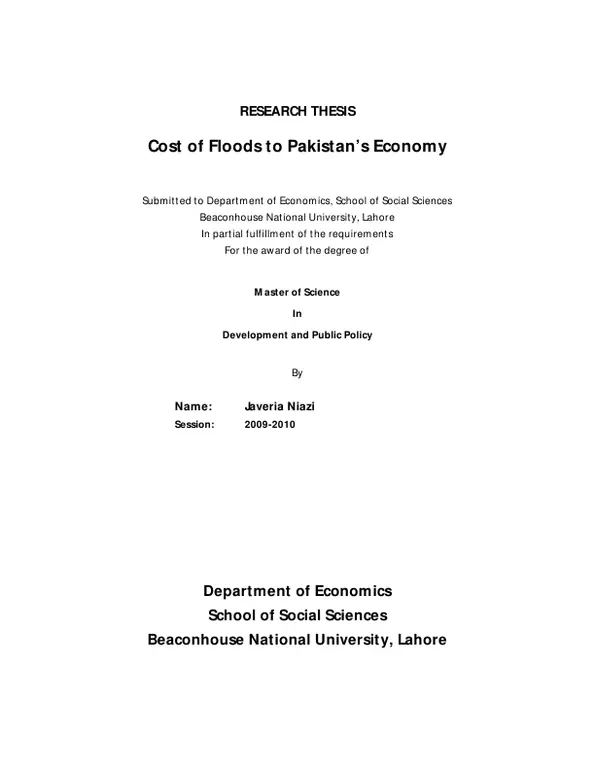The thesis reviews the available literature on measuring the direct and indirect impacts of natural disasters, both in the short run and in the long run. Based on this review, an attempt is made to quantify the economic impact of the recent floods in Pakistan. This will include not only the estimates emerging from the Damage Needs Assessment by the World Bank and ADB but also derivation of the second round multiplier effects on the GDP by use of the IPP Macroeconomic
Model. In addition, an assessment will be made of the prospects for revival of growth.
Inhaltsverzeichnis (Table of Contents)
- Acknowledgements
- Table of Contents
- List of Tables
- List of Figures
- Abstract
- Chapter 1: Introduction
- 1.1 Introduction
- 1.2 The 2010 Floods
- 1.3 Objectives
- 1.4 The Scope of the Study
- Chapter 2: Literature Review
- 2.1 Introduction
- 2.2 Theoretical Framework
- 2.3 Empirical Studies on Floods
- 2.4 Findings and Policy Recommendations
- Chapter 3: Theoretical Framework and Empirical Results
- 3.1 Introduction
- 3.2 The Model
- 3.3 Data Sources and Methodology
- 3.4 Estimation Results
- Chapter 4: Simulation of the Model
- 4.1 Introduction
- 4.2 Simulation Results
- Chapter 5: Conclusion and Policy Recommendation
- Appendix
- References
Zielsetzung und Themenschwerpunkte (Objectives and Key Themes)
This thesis aims to analyze the economic impact of the 2010 floods in Pakistan, focusing on quantifying the damage caused to different sectors of the economy and estimating the overall economic impact. The thesis also explores potential policy recommendations to mitigate future flood risks and enhance the country's resilience. Here are the key themes explored in the thesis:- Economic impact of natural disasters, specifically floods, on a developing country like Pakistan.
- Quantitative assessment of the damage caused to various sectors of the economy by the 2010 floods.
- Development and application of an econometric model to simulate the impact of floods on economic growth.
- Evaluation of the effectiveness of existing policies and identification of potential policy recommendations for flood mitigation and risk reduction.
Zusammenfassung der Kapitel (Chapter Summaries)
- Chapter 1: Introduction: This chapter provides an overview of the 2010 floods in Pakistan, highlighting their severity and widespread impact. It sets the context for the study by discussing the objectives, scope, and significance of the research.
- Chapter 2: Literature Review: This chapter reviews existing literature on the economic impact of floods, examining theoretical frameworks and empirical studies conducted in different contexts. It identifies key findings and policy recommendations from previous research, setting the stage for the current study.
- Chapter 3: Theoretical Framework and Empirical Results: This chapter presents the econometric model used to analyze the impact of floods on the Pakistani economy. The model's variables, data sources, and estimation methodology are discussed in detail. The chapter then presents the empirical results of the model, quantifying the economic impact of the floods.
- Chapter 4: Simulation of the Model: This chapter utilizes the developed model to simulate different scenarios, exploring the potential long-term economic impact of floods. The chapter analyzes the model's projections and discusses their implications for policymakers.
Schlüsselwörter (Keywords)
This thesis focuses on the economic impact of floods in Pakistan, using econometric modeling to assess the damage to various sectors and estimate the overall economic impact. Key terms include natural disasters, economic impact, flood damage, econometric modeling, policy recommendations, flood mitigation, and risk reduction. The study specifically explores the 2010 floods in Pakistan, drawing on data from the National Disaster Management Authority (NDMA).
Fin de l'extrait de 58 pages
- haut de page
- Citation du texte
- Javeria Niazi (Auteur), 2010, Costs of Floods to Pakistan's Economy, Munich, GRIN Verlag, https://www.grin.com/document/198996
Lire l'ebook



